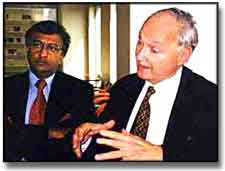
Mahendra Shah (l) of the World Bank with Maurice F. Strong, president of the Earth Council |
Global experts arm themselves for a 'green revolution' |
|
(c) Earth Times News Service |
An upcoming global "second green revolution" - based largely on biotechnology- could cause even greater economic, social and political disruptions than the first green revolution, according to a panel of 27 international experts who have spent the past 18 months studying a key factor in global agricultural research. The focus of the study was the Consultative Group on International Agricultural Research (CGIAR), a network of 16 publicly financed research institutions with an annual budget of $350 million. Ismail Serageldin, who is CGIAR's Chairman and Vice President of the World Bank, responded to the panel's findings by noting that enormous sums are being invested in biotechnology research by business--which last year poured $9 billion into it in the United States alone. In this "proprietary science regime," Serageldin noted, "both products and processes are being patented and their release is tightly regulated. The key question is how the benefits of the new propriety science can be harnessed for the needs of the poor and the environment. This is the challenge to the CGIAR." Maurice F. Strong, who was Secretary General of the Rio Earth Summit and now presides over the Earth Council, served as chair of the CGIAR review panel. After its report was completed, he told The Earth Times the panel found that the network was prepared for what he called "the doubly green revolution"--green in the sense that it would produce more bountiful crops and also in the sense that it could protect the environment. He said the system's "capacity to deal with negative impacts has improved immensely." He said that the anticipated rapid growth in the world's population--especially in those parts of the world least affected by the first green revolution--creates an "immense need to increase agricultural productivity." Strong noted that the first green revolution produced vast social and political repercussions, as less labor-intensive farming techniques forced millions of people off the land and into cities. The new revolution is continuing this trend, he said, but at a much faster pace. "We have a special responsibility," he added, "to protect those most vulnerable to the risks of this revolution." On the other hand, he said, despite the risks, agricultural research is "an absolute win-win investment," providing a return of $2.50 for every $1 invested. In some areas the returns have been even more dramatic. Mahendra M. Shah, executive secretary of the CGIAR review panel, said that each dollar invested in research into wheat produced a return of $191--in the US alone. Strong said the panel called for a new mission statement for CGIAR, which he described as "uniquely positioned to be a bridge, transferring information and technology from the scientists to the farmers and combining farmers' traditional knowledge with the contributions of science." Strong added that laboratory scientists find they are able to learn a great deal from so-called traditional farming techniques, just as modern Western medicine has learned much from acupuncturists, herbalists and practitioners of "folk medicine." CGIAR was founded in 1971 as a response to concerns that rising populations in developing countries were outstripping the world's capacity to provide food for them. It brought together leaders from the Ford and Rockefeller foundations, the UN's Food and Agriculture Organization (FAO), the UN Development Program (UNDP) and the World Bank, working in partnership with governments of both developing and industrialized countries. It has sponsored extensive research into aquatic resources, biodiversity, food crops, forestry and agroforestry, livestock, soil and water nutrients, water management and agriculture-related policies. "This is a most exciting time in agricultural history," Strong said. All sorts of possibilities are opening up--food crops with higher yields and better nutrition content, plants that resist drought and pests, livestock that are immune to disease and fisheries that are sustainable. But this isn't just a scientific revolution. It's a revolution that's going to drive social and economic reactions, even conflicts. . . . It's important that we develop means to ensure that private control of patented products like seeds does not produce risks and disadvantages for the poor."
Original story on Earth Times website |
|
| Copyright © 1998 The Earth Times All rights reserved. | |
| Return to SAANTI DHARMA Current Issue |
Return to SAANTI DHARMA Archive |